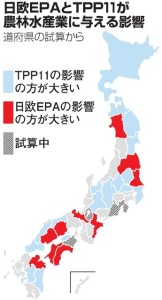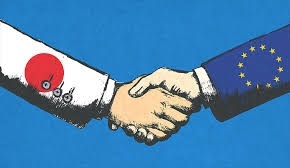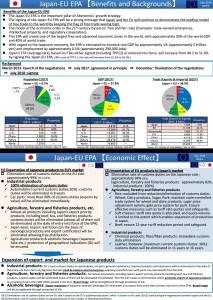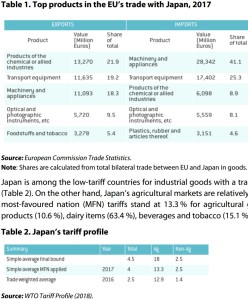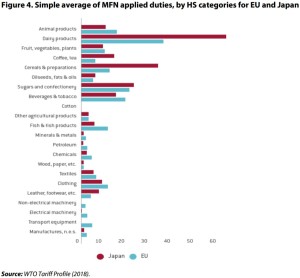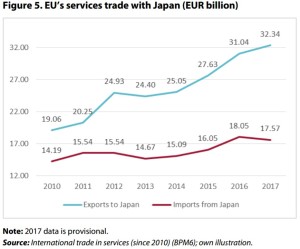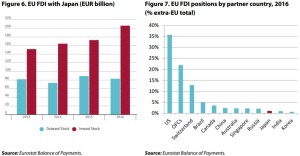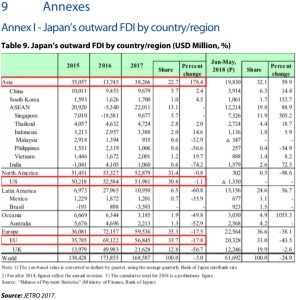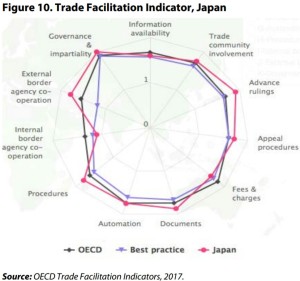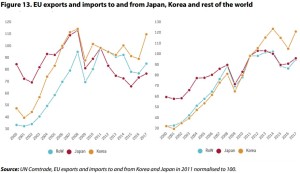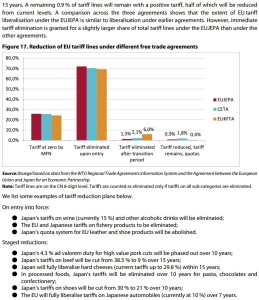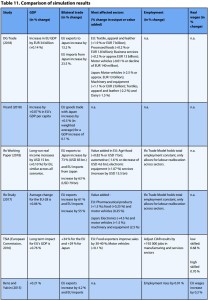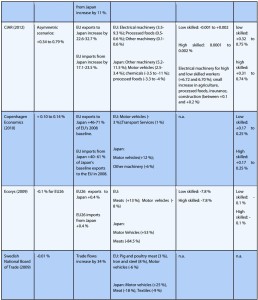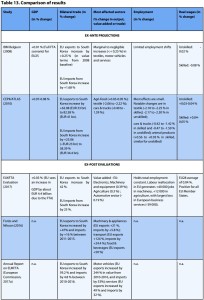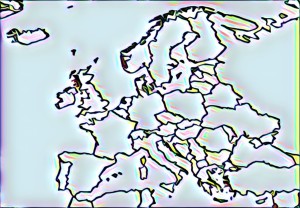All the below links and excerpts are in Japanese. Next post about this topic will be in English.
取り急ぎ標記につき以下のとおりリンク及び抜粋等を貼っておきます。次回、英文情報を貼ります。
平成31年2月13日、数件追加しました。
TPP協定の経済効果分析について(PDF;平成27年12月24日)| 内閣官房TPP政府対策本部 平成31年2月13日追加
(別紙)農林水産物への影響試算の計算方法について(PDF;平成25年3月15日)| 内閣官房TPP政府対策本部 平成31年2月13日追加
内閣官房TPP等政府対策本部
環太平洋パートナーシップ(TPP)協定交渉(平成30年11月19日)| 外務省
日EU‣EPAとTPP11の概要と海外支援について(PDF;平成30年3月)| 経済産業省
下表“TPP11:相手国及び我が国の工業製品の即時撤廃率及び関税撤廃率”等をご覧ください。
経済連携協定の活用(PDF;平成29年12月1日)| 経済産業省 経済連携課
TPP11協定(CPTPP)の概要(税率差等)(PDF;平成30年11月)| 財務省関税局
セーフガードに係る説明や、下の“【例1】~【例3】税率差が3%…”等をご覧ください。
TPP11(CPTPP)原産地規則について(PDF;平成30年11月・12月)| 財務省関税局・税関
TPP11における品目ごとの農林水産物への影響について(PDF;平成29年12月)| 農林水産省
農林水産物の生産額への影響について(TPP11)(PDF;平成29年12月)| 農林水産省
TPP11協定に基づく国家貿易による米麦等の輸入について(w PDFs)| 農林水産省
TPP11、12月30日発効 | 独立行政法人 農畜産業振興機構
TPP大筋合意 食卓への影響は? 価格帯も豊富、選択肢広がる(平成27年10月15日)| 産経新聞 平成31年2月13日追加
例えば、同店で現在、最も安く販売している米国産牛肉は100グラム当たり150円。38・5%の関税がかかってこの値段だが、関税が27・5%になると同138円、9%だと同118円となる。一方、同店で販売する国産豚肉の平均価格は100グラム当たり128円。現在は米国産牛肉の方が22円高いが、TPPで関税が27・5%になれば、価格差は10円に縮まる。さらに9%になると牛肉と豚肉の価格が逆転し、牛肉の方が豚肉より10円安くなる。
ただ、輸入の豚肉にかかる関税は、安い価格帯の豚肉が現行の1キロ当たり482円を10年目に50円に、高い豚肉の関税(価格の4・3%)を10年目に撤廃する方向で、輸入の牛肉よりもさらに安くなる可能性がある。
一方、輸入肉の価格が安くなることで、輸入や国産に関係なく、魚介類の価格も下がるとみられる。全国漁業協同組合連合会(全漁連)によると、総務省の消費者物価指数の動きから、牛肉の価格が20%下がると、魚介類の価格が15%下がるという関係が認められるという。
スーパーなどで品薄が続いているバターについては、新たに低関税の輸入枠が設けられる。ニュージーランドなどからの輸入が増え、品不足の解消が期待される。
【図解・行政】TPP新協定発効後の食品関税(平成29年11月)| 産経新聞 平成31年2月13日追加
包括的及び先進的な環太平洋パートナーシップ協定(TPP11協定)交渉の大筋合意に伴う熊本県産農林水産物への定性的な影響予測(PDF;平成29年12月11日)| 熊本県農林水産部
米、小麦、牛肉、豚肉、乳製品、オレンジ(温州みかん・中晩柑類)、野菜(施設野菜)、野菜(露地野菜)、鶏肉、鶏卵、林産物(合板・製材)、水産物について説明されています。
なお、同県以外の各都道府県等も同様の資料を公表されています。下の日本都道府県地図もご覧ください。
TPP協定の影響に関するQ&A(PDF;平成25年5月)| 北海道 平成31年2月13日追加
TPP11の発効について | 帯広市
<迫るTPP11 現場からの報告>(1)牛肉 黒毛輸出や銘柄化模索(2018年4月13日)| 北海道新聞
TPPの国民生活への影響|JAグループ宮城 平成31年2月13日追加
TPP 12月30日発効 米国離脱も見直さず(2018年11月1日)| 日本農業新聞
バター・脱脂粉乳で設けた生乳換算で最大7万トンの低関税輸入枠や牛肉のセーフガードの発動基準数量は、参加国全体からの輸入が対象。TPP11では元の12カ国の水準を維持した。例えば牛肉の発動基準数量は米国からの輸入を含むことを前提に設定しており、米国が抜けたため実際は発動されない可能性が高い。
牛肉の関税は、1年目に現行の38・5%から27・5%に削減。その後、段階的に削減し、16年目に9%になる。豚肉は差額関税制度を維持した上で、低価格帯の従量税、高価格帯の従価税を段階的に下げ、最終的に従量税1キロ当たり50円だけになる。米はオーストラリア向けに特別輸入枠を設ける。
TPP11、12月30日に発効へ(2018年11月2日)| 鶏鳴新聞
鶏肉の「丸どり=生鮮・冷蔵」と「丸どり、骨付きもも以外=冷凍」「アヒルの肉(丸どり以外)」は段階的に下げて6年目に撤廃。鶏肉の「丸どり=冷凍」「骨付きもも=生鮮・冷蔵」「丸どり・骨付きもも以外=生鮮・冷蔵」「骨付きもも=冷凍」は段階的に下げて11年目に撤廃。
けいざい早わかり(2017 年度第 5 号)署名されたTPP11の概要(PDF;2018年3月9日)| 三菱UFJリサーチ&コンサルティング
図表2.TPP1 1における日本の農林水産物の関税の削減・撤廃の例
CPTPPが年末に発効(PDF;2018年11月1日)| みずほ総合研究所
カナダの乗用車関税は、現在の6.1%から発効日に5.5%、2019年1月1日には5.0%に引き下げられる。カナダの工業製品関税の対日即時撤廃率は、日本の対加輸出額の3割強を占める乗用車が即時撤廃ではないため、貿易額基準でみると68.4%にとどまるが、関税品目数基準では96.9%に達している。ニュージーランドの工業製品関税の対日即時撤廃率は、貿易額基準では98.0%、関税品目数基準でも93.9%と高い水準になっている(図表1)。
日本の牛肉輸入のうち、CPTPP参加国からの輸入は56.7%(2017年実績、金額ベース)を占め、その大半(49.8%)がオーストラリアからの輸入である(4頁図表3参照)。オーストラリア向けの牛肉関税は、日豪EPAによって生鮮・冷蔵が29.3%、冷凍が26.9%まですでに引き下げられている。そのため、オーストラリア産牛肉の輸入に関しては、CPTPP発効によって関税率が大きく引き下げられるわけではない。特に、冷凍牛肉については、日豪EPAに基づく現行関税率の方が低くなるため、CPTPP発効後も日豪EPAの関税率が適用される5。2019年4月1日(2年目)以降は、CPTPPにおける関税率(26.6%)が日豪EPAにおける関税率(26.7%)を下回る…
日本の輸入牛肉の56.7%がCPTPP参加国からの輸入であることはすでに述べたが、残る43.3%のうち43.0%を米国が占めている(図表3左図)。つまり、CPTPP発効後は、事実上米国のみがCPTPPの特恵関税率を適用されない国となる。また、豚肉については、日本の輸入豚肉市場はCPTPP参加国(35.3%)、EU(35.9%)、米国(28.7%)で3分されており(図表3右図)…
TAG交渉が長引けば、それだけ米国の輸出者が日本市場で不利な状況に置かれる期間が長くなることを意味する。したがって、CPTPPの発効は、TAG交渉の早期妥結を求める米国内の圧力を高め、交渉における米国の姿勢をより宥和的にする方向に働くことが考えられる。
米国のTPP復帰は米国が譲歩しないと実現しない(2018年4月18日)| 野村総合研究所
米国のTPP復帰に対する11か国の姿勢には、実は大きな開きがある。日本が米国の復帰を望んでいるのは、米国市場へのアクセスが強まり、輸出が拡大するとの期待があるためである。日本以外にも、マレーシアやベトナムには同様な期待がある。しかし一方で、米国が参加しないことでメリットを受けている国もある点に留意すべきだ。それが最も顕著なのは北米・南米の4ヵ国、つまりカナダ、チリ、メキシコ、ペルーである。これらの4か国は既に米国との間に北米自由貿易協定(NAFTA)などの協定を結んでいることから…
米国抜きTPPの行方(PDF;2017年11月15日)| 三井物産戦略研究所 アジア・中国・大洋州室
TPP参加国のうち、 米国がFTAを結んでいない国は、日本に加えベトナム、マレーシア、ブルネイ、ニュージーランドの4カ国である。…
TPP参加国のうち、 日本がFTAを結んでいないのは、米国とニュージーランドおよび交渉中のカナダだけ…
ベトナム、マレーシア… 米国抜き TPP に慎重。両国ともTPP交渉で、米国への輸出拡大を期待し、国内規制の緩和を受け入れた。そのため、米国抜きTPPでは、期待した利益の多くが得られない一方で、規制緩和の痛みばかり負うことになると懸念している。 また、すでに日本とはEPAを結んでいるので、特段日本への輸出拡大は期待できない…
TPPにおける日本の牛肉関税の削減幅は、日豪EPAより大きく、TPP11では一層、豪州が有利となる。同試算では、豪州のTPP11参加国向け輸出の押し上げ効果は8,800万ドルとなる。…
ニュージーランドがTPPに参加したのは、日本とのFTA実現の意味合いが大きかったので、米国抜きのTPPでもあまり期待外れにはならない。…ニュージーランドのTPP12参加国向け輸出の押し上げ効果は17億4,200万ドルだったが、TPP11では 15億5,600万ドルとなり、大きく目減りすることはない。…
日本農業を壊すのは自由貿易ではない | キャノングローバル戦略研究所
1.TPPを悪用した農業界
4.ウソと矛盾の農業保護論
TPP11の次の一手は-アメリカにTPP復帰を求める必要はない- | キャノングローバル戦略研究所
農産物の日本市場をTPP11で奪われるアメリカが日米FTAを要求してくるなら、日本は多国間自由貿易協定(メガFTA)主義に転換したのでTPP11に参加しなさいと主張すればよい。理論的にも… TPP11に地理的な制約はない。トルコ、ブラジル、ケニアが入ってもよい。… 当初EUは日EU自由貿易協定に関心を示さなかった。…転換… 中国・インドも参加するRCEPでは、TPPのような高いレベルの協定内容は期待できない。…
動きだした米抜きTPP――日本がアジアの通商交渉リードへ(2017年7月18日)| 独立行政法人 経済産業研究所
… 米国が検事兼裁判官となって気に入らない国に制裁を一方的に加える通商法301条に、80年代の日本はおびえた。しかし、WTOはその紛争処理手続きを経なければ対抗措置は打てないとして、通商法301条を否定した。
日米FTA交渉を求められても、日本は拒否すればよい。日米FTAは望ましくないと、米国を諭すのである。第1に、TPPはアジア太平洋経済協力会議(APEC)地域全体の自由貿易圏(FTAAP)実現に向けた取り組みの1つとして位置付けられてきた。APEC首脳が約束してきた道から外れて、2国間のFTAを目指すことは適当ではない。第2に、2国間のFTAが重なると、多数のルールや規則が錯綜し混乱する。これをバグワティという著名な国際経済学者は「スパゲティボール」と呼んで批判している。…
7 日本はどの国と業種からTPP11のメリットを得られるか ―EPAとTPPの利用における効果を業種別に比較(PDF;2018年6月) |(一財)国際貿易投資研究所
表1 TPPにおける輸入の平均関税率(発効から1年目、加重平均)
表2 日本のTPP10か国からの輸入の平均関税率(発効から1年目、加重平均)
表3 日本のTPP10か国からの輸入の業種別平均関税率(発効から1年目、加重平均)
表4 日本のマレーシア・ベトナムからの輸入でのEPAとTPPの業種別効果(加重平均)
表5 日本のマレーシア・ベトナムからの輸入でのEPAとTPPの品目別効果(加重平均)
表6 日本のTPP10か国からの輸入の関税削減額及び関税削減率(発効から1年目、加重平均)
表7 日本のTPP10か国からの輸入の業種別関税削減額及び関税削減率(発効から1年目、加重平均)
表8 日本のマレーシア・ベトナムからの輸入でのEPAとTPPの品目別関税削減額および関税削減率(加重平均)
表9 日本のTPPを利用した輸出の効果(2017年、関税削減額および削減率、加重平均)
99頁 したがって、日本が TPP を活用してより多くのメリットを得ようとすると、米国以外の TPP 11 か国への輸出では、農水産品と食料品・アルコール、皮革・毛皮・ハンドバッグ(主にベトナム向け)、繊維製品・履物、輸送用機械・部品、などの分野が有望である。米国向け輸出では、繊維製品・履物、化学工業品、プラスチック・ゴム製品、などの分野でメリットが大きい。
一方、日本の輸入では、TPP 利用でメリットが大きい業種は、農水産品と食料品・アルコールであり、これに繊維製品・履物とプラスチック・ゴム製品が挙げられる。つまり、農水産品と食料品・アルコール、及び繊維製品・履物は、日本の TPP を利用した輸出と輸入の両面において効果がある業種ということになる。
TPPの関税低減に先駆けタスマニアビーフ2品値下げ(平成30年12月6日)| イオンリテールnews 平成31年2月13日追加
機関誌「あきた経済」:「TPP12」から「TPP11」に ~貿易摩擦とメガFTAの行方~ | 一般財団法人 秋田経済研究所
カナダ向け輸出増期待 TPP11署名で北陸企業(2018年3月9日)| 北國新聞
TPP11やEVFTA、ベトナムの農林水産業発展のチャンスに(2018年11月29日)| VIETJO
自由貿易体制に備えて ~TPP11、12月30日発効へ~(2018年11月28日)| ニコニコニュース(食品産業新聞社ニュースWEB)
TPP11はTPP12より悪い(2018年5月31日)| JAcom【鈴木宣弘・東京大学教授】
TPP11 の農業分野への影響について(PDF;2018年4月11日)| 農民運動全国連合会
日米新協議いよいよ始動 TPP11 テコに自由化加速 | 一般社団法人 中央酪農会議
TPP11発効まで1カ月 輸入枠見直さず セーフガード発動しない可能性(2018年12月1日)| 日本農業新聞
TPP11 合意から1年で発効 迫る大幅市場開放(2018年11月1日)| 日本農業新聞
TPPの現在 ~米国の離脱と署名が行われたTPP11 | 三菱UFJリサーチ&コンサルティング
再起動した日本の通商戦略(PDF;2017年10・11月)| みずほ総合研究所 政策調査部
アセアン・レポート 2018年3月号(PDF)| 千葉銀行 シンガポール駐在員事務所・バンコク駐在員事務所
「TPP11大筋合意~日本の果たす役割」(時論公論)(2017年11月14日)| NHK解説委員室
また自由化の内容もやや後退しています。アメリカが求めていた知的財産権の保護など20項目が、アメリカがTPPにもどるまで実施されない「凍結」扱いとなりました。また「国有企業に対する優遇措置を禁じる新たなルール」など4項目についても新興国などが、「そもそもアメリカへの輸出が増やせることを前提に譲歩したものだ」として、凍結を主張していました。結局調整がつかずに継続協議となり、今後に課題を残しています。
大筋合意に至ったTPP11(PDF;2017年11月13日)| みずほ総合研究所
図表2:凍結項目リスト
TPP11を読む(2018年4月19日)| 独立行政法人 経済産業研究所
表1:TPP11に組み込まれないか、適用停止されるTPP12の条文
表2:TPP11における我が国のサイドレター
TPP11、12月30日に発効へ 著作権保護期間は70年に(2018年11月2日)| 財経新聞
TPP11と不動産(PDF;2018年4月3日)| 一般財団法人 土地総合研究所
オーストラリア連邦(Commonwealth of Australia) 基礎データ | 外務省
ニュージーランド(New Zealand) 基礎データ | 外務省
カナダ(Canada) 基礎データ | 外務省
メキシコ合衆国(United Mexican States) 基礎データ | 外務省
シンガポール共和国(Republic of Singapore) 基礎データ | 外務省
ベトナム社会主義共和国(Socialist Republic of Viet Nam) 基礎データ | 外務省 平成31年2月13日追加



